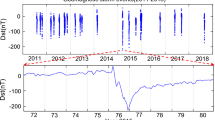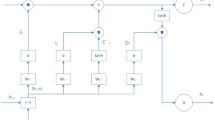Abstract
The Total Electron Content (TEC) computed from ionospheric models is a widely used parameter for characterizing the morphological structure of the ionosphere. The global TEC maps from empirical models, like the International Reference Ionosphere (IRI) model, have limited accuracy compared to those calculated by dual-frequency measurements from the global navigation satellite systems (GNSS). We have developed a reconstructed IRI TEC model for generating high-precision global TEC maps based on a deep learning method. For this, we have collected 48,204 pairs of global TEC maps from the IRI-2020 model and Global Ionosphere Maps (GIM) model with 2-h time resolution from 2009 to 2019 covering the whole solar cycle 24. The daily solar radio flux (F10.7), sunspot number (SSN), Dst, and Kp indices are also introduced as input features to train the model. We have investigated the optimum combination of the input parameters for the reconstructed TEC model and compared the performance of the model during the years with high and low solar activity levels. Results show that the reconstructed TEC model with F10.7 and Kp features has a better performance compared to that considering all solar and geomagnetic indices. The global TEC maps predicted from our model are much more consistent with the corresponding TEC maps from the GIM model than those from the IRI-2020 model. Especially, the large-scale equatorial ionospheric anomaly (EIA) crests and the pronounced enhancement of TEC are well predicted by the reconstructed TEC model. From statistical metrics, the accuracy of the reconstructed TEC model increased by 40.8% during the high solar activity year 2015 and 43.0% during the low solar activity year 2018 compared with the IRI-2020 model. The prediction performance of the reconstructed TEC model also shows better accuracy during the storm periods.












Similar content being viewed by others
Data availability
The GIM TEC maps are available from the CAS analysis center (ftp://ftp.gipp.org.cn/product/ionex/). The daily solar radio flux (F10.7), sunspot number (SSN), Dst, and Kp indices are available from the GSFC/SPDF OMNIWeb (https://omniweb.gsfc.nasa.gov/form/dx1.html). The IRI‐2020 model source code in Fortran was available from the IRI homepage (http://www.irimodel.org/).
References
Araujo-Pradere EA, Fuller-Rowell TJ, Codrescu MV (2002) STORM: an empirical storm-time ionospheric correction model: 1. Model Descr Radio Sci 37(5):1–12
Astafyeva E, Yasyukevich YV, Maletckii B, Oinats A, Vesnin A, Yasyukevich AS, Guendouz N (2022) Ionospheric Disturbances and Irregularities during the 25–26 August 2018 geomagnetic storm. J Geophys Res Space Phys 127(1):e2021JA029843
Bilitza D, Reinisch BW (2008) International reference ionosphere 2007: improvements and new parameters. Adv Space Res 42(4):599–609
Bilitza D, Xiong C (2021) A solar activity correction term for the IRI topside electron density model. Adv Space Res 68(5):2124–2137
Bilitza D, Altadill D, Zhang Y, Mertens C, Truhlik V, Richards P, Reinisch B (2014) The international reference ionosphere 2012–a model of international collaboration. J Space Weather Space Clim 4:A07
Bilitza D, Altadill D, Truhlik V, Shubin V, Galkin I, Reinisch B, Huang X (2017) International reference ionosphere 2016: from ionospheric climate to real-time weather predictions. Space Weather 15(2):418–429
Bilitza D, Pezzopane M, Truhlik V, Altadill D, Reinisch BW, Pignalberi A (2022) The International Reference Ionosphere model: A review and description of an ionospheric benchmark. Rev Geophys 60(4):e2022RG000792
Blagoveshchensky DV (2018) Sergeeva MA (2020) Ionospheric parameters in the European sector during the magnetic storm of August 25–26. Adv Space Res 65(1):11–18
Bolaji OS, Fashae JB, Adebiyi SJ, Owolabi C, Adebesin BO, Kaka RO, Younas W (2021) Storm time effects on latitudinal distribution of ionospheric TEC in the American and Asian-Australian sectors: August 25–26, 2018 geomagnetic storm. J Geophys Res Space Phys 126(8):e2020JA029068
Boulch A, Cherrier N, Castaings T (2018) Ionospheric activity prediction using convolutional recurrent neural networks. arXiv preprint arXiv:1810.13273.
Bust GS, Mitchell CN (2008) History, current state, and future directions of ionospheric imaging. Rev Geophys. https://doi.org/10.1029/2006RG000212
Chen Z, Jin M, Deng Y, Wang JS, Huang H, Deng X, Huang CM (2019) Improvement of a deep learning algorithm for total electron content maps: image completion. J Geophys Res Space Phys 124(1):790–800
Chen J, Ren X, Zhang X, Zhang J, Huang L (2020a) Assessment and validation of three ionospheric models (IRI-2016, NeQuick2, and IGS-GIM) from 2002 to 2018. Space Weather 18(6):e2019SW002422
Chen M, Liu L, Xu C, Wang Y (2020b) Improved IRI-2016 model based on BeiDou GEO TEC ingestion across China. GPS Solut 24(1):1–11
Chen Z, Liao W, Li H, Wang J, Deng X, Hong S (2022) Prediction of global ionospheric TEC based on deep learning. Space Weather 20(4):e2021SW002854
Dehvari M, Karimi S, Farzaneh S, Sharifi MA (2023) Improving IRI-2016 global total electron content maps using ELM neural network. Adv Space Res 72(9):3903–3918
Fagundes PR, Cardoso FA, Fejer BG, Venkatesh K, Ribeiro BAG, Pillat VG (2016) Positive and negative GPS-TEC ionospheric storm effects during the extreme space weather event of March 2015 over the Brazilian sector. J Geophys Res Space Phys 121(6):5613–5625
Forbes JM, Palo SE, Zhang X (2000) Variability of the ionosphere. J Atmos Solar Terr Phys 62(8):685–693
Graves A (2013) Generating sequences with recurrent neural networks. arXiv preprint arXiv:1308.0850.
Habarulema JB, McKinnell LA, Cilliers PJ (2007) Prediction of global positioning system total electron content using neural networks over South Africa. J Atmos Solar Terr Phys 69(15):1842–1850
Hernandez-Pajares M, Juan JM, Sanz J, Bilitza D (2002) Combining GPS measurements and IRI model values for space weather specification. Adv Space Res 29(6):949–958
Hernández-Pajares M, Juan JM, Sanz J, Orus R, Garcia-Rigo A, Feltens J, Krankowski A (2009) The IGS VTEC maps: a reliable source of ionospheric information since 1998. J Geodesy 83(3):263–275
Hochreiter S, Schmidhuber J (1997) Long short-term memory. Neural Comput 9(8):1735–1780
Jee G, Lee HB, Kim YH, Chung JK, Cho J (2010) Assessment of GPS global ionosphere maps (GIM) by comparison between CODE GIM and TOPEX/Jason TEC data: ionospheric perspective. J Geophys Res Space Phys 115:A10
Ji EY, Moon YJ, Park E (2020) Improvement of IRI global TEC maps by deep learning based on conditional generative adversarial networks. Space Weather 18(5):e2019SW002411
Kedar S, Hajj GA, Wilson BD, Heflin MB (2003) The effect of the second order GPS ionospheric correction on receiver positions. Geophys Res Lett. https://doi.org/10.1029/2003GL017639
Kingma DP, Ba J (2014) Adam: A method for stochastic optimization. arXiv preprint arXiv:1412.6980.
Kumar S, Tan EL, Murti DS (2015) Impacts of solar activity on performance of the IRI-2012 model predictions from low to mid latitudes. Earth Planets Space 67(1):1–17
LeCun Y, Bottou L, Bengio Y, Haffner P (1998) Gradient-based learning applied to document recognition. P IEEE 86(11):2278–2324
Lee S, Ji EY, Moon YJ, Park E (2021) One-day forecasting of global TEC using a novel deep learning model. Space Weather 19(1):2020SW002600
Li Z, Yuan Y, Wang N, Hernandez-Pajares M, Huo X (2015) SHPTS: towards a new method for generating precise global ionospheric TEC map based on spherical harmonic and generalized trigonometric series functions. J Geodesy 89(4):331–345
Li Z, Wang N, Liu A, Yuan Y, Wang L, Hernández-Pajares M, Yuan H (2021) Status of CAS global ionospheric maps after the maximum of solar cycle 24. Satell Navig 2(1):1–15
Liu L, Zou S, Yao Y, Wang Z (2020) Forecasting global ionospheric tec using deep learning approach. Space Weather 18(11):e2020SW002501
Liu L, Morton YJ, Liu Y (2022) ML prediction of global ionospheric TEC maps. Space Weather 20(9):e2022SW003135
McGranaghan RM, Mannucci AJ, Verkhoglyadova O, Malik N (2017) Finding multiscale connectivity in our geospace observational system: network analysis of total electron content. J Geophys Res Space Phys 122(7):7683–7697
Migoya-Orué Y, Nava B, Radicella S, Alazo-Cuartas K (2015) GNSS derived TEC data ingestion into IRI 2012. Adv Space Res 55(8):1994–2002
Nava B, Coisson P, Radicella SM (2008) A new version of the NeQuick ionosphere electron density model. J Atmos Solar Terr Phys 70(15):1856–1862
Nayak C, Tsai LC, Su SY, Galkin IA, Tan ATK, Nofri E, Jamjareegulgarn P (2016) Peculiar features of the low-latitude and midlatitude ionospheric response to the St. Patrick’s Day geomagnetic storm of 17 March 2015. J Geophys Res Space Phys 121(8):7941–7960
Okoh D, McKinnell LA, Cilliers P, Okeke P (2013) Using GPS-TEC data to calibrate VTEC computed with the IRI model over Nigeria. Adv Space Res 52(10):1791–1797
Olwendo OJ, Baki P, Cilliers PJ, Mito C, Doherty P (2013) Comparison of GPS TEC variations with IRI-2007 TEC prediction at equatorial latitudes during a low solar activity (2009–2011) phase over the Kenyan region. Adv Space Res 52(10):1770–1779
Perez RO (2019) Using TensorFlow-based Neural Network to estimate GNSS single frequency ionospheric delay (IONONet). Adv Space Res 63(5):1607–1618
Pezzopane M, Pignalberi A, Nava B (2023) On the low-latitude NeQuick topside ionosphere mismodelling: the role of parameters H0, g, and r. Adv Space Res 72:1224–1236
Piersanti M, De Michelis P, Del Moro D, Tozzi R, Pezzopane M, Consolini G, Diego P (2020) From the sun to the earth: August 25, 2018 geomagnetic storm effects. Ann Geophys 38:703–724
Pignalberi A, Pezzopane M, Themens DR, Haralambous H, Nava B, Coïsson P (2020) On the analytical description of the topside ionosphere by NeQuick: modeling the scale height through COSMIC/FORMOSAT-3 selected data. IEEE J Sel Topics Appl Earth Observ Remote Sens 13:1867–1878
Rao SS, Chakraborty M, Kumar S, Singh AK (2019) Low-latitude ionospheric response from GPS, IRI and TIE-GCM TEC to Solar Cycle 24. Astrophys Space Sci 364(12):1–14
Rawer K, Bilitza D, Ramakrishnan S (1978) Goals and status of the international reference ionosphere. Rev Geophys 16(2):177–181
Rishbeth H, Mendillo M (2001) Patterns of F2-layer variability. J Atmos Solar Terr Phys 63(15):1661–1680
Roma-Dollase D, Hernández-Pajares M, Krankowski A, Kotulak K, Ghoddousi-Fard R, Yuan Y, Li Z, Zhang H, Shi C, Wang C, Feltens J (2018) Consistency of seven different GNSS global ionospheric mapping techniques during one solar cycle. J Geodesy 92(6):691–706
Shi C, Zhang T, Wang C, Wang Z, Fan L (2019) Comparison of IRI-2016 model with IGS VTEC maps during low and high solar activity period. Results Phys 12:555–561
Shi X, Chen Z, Wang H, Yeung DY, Wong WK, Woo WC (2015) Convolutional LSTM network: A machine learning approach for precipitation nowcasting. arXiv preprint arXiv:1506.04214.
Shubin VN (2015) Global median model of the F2-layer peak height based on ionospheric radio-occultation and ground-based Digisonde observations. Adv Space Res 56(5):916–928
Shubin VN, Karpachev AT, Tsybulya KG (2013) Global model of the F2 layer peak height for low solar activity based on GPS radio-occultation data. J Atmos Solar Terr Phys 104:106–115
Srivani I, Prasad GS, Ratnam DV (2019) A deep learning-based approach to forecast ionospheric delays for GPS signals. IEEE Geosci and Remote Sens Lett 16(8):1180–1184
Uwamahoro JC, Habarulema JB, Okouma PM (2018) Storm time total electron content modeling over African low-latitude and midlatitude regions. J Geophys Res Space Phys 123(9):7889–7905
Xiong P, Zhai D, Long C, Zhou H, Zhang X, Shen X (2021) Long short-term memory neural network for ionospheric total electron content forecasting over China. Space Weather 19(4):e2020SW002706
Xu B, Wang N, Chen T, Li M (2015) Empirical evaluation of rectified activations in convolutional network. arXiv preprint arXiv:1505.00853.
Acknowledgements
This work was supported by the National Natural Science Foundation of China (Grant nos. 41721003, 41874033, 42142037). The authors acknowledge the IRI Working Group for providing the IRI-2016 model, the CAS analysis center for providing the gridded TEC data, and NASA’s Goddard Space Flight Center (GSFC) for providing solar and geomagnetic indices.
Author information
Authors and Affiliations
Contributions
YBY and XG provided the initial idea and designed the research; XG and Yang Wang developed the program and processed data; XG wrote the manuscript. All authors provided critical feedback and helped shape the analysis and manuscript.
Corresponding author
Ethics declarations
Conflict of interest
The authors declare that they have no competing interests.
Rights and permissions
Springer Nature or its licensor (e.g. a society or other partner) holds exclusive rights to this article under a publishing agreement with the author(s) or other rightsholder(s); author self-archiving of the accepted manuscript version of this article is solely governed by the terms of such publishing agreement and applicable law.
About this article
Cite this article
Gao, X., Yao, Y. & Wang, Y. Reconstruction of global ionospheric TEC maps from IRI-2020 model based on deep learning method. J Geod 98, 10 (2024). https://doi.org/10.1007/s00190-023-01818-x
Received:
Accepted:
Published:
DOI: https://doi.org/10.1007/s00190-023-01818-x




